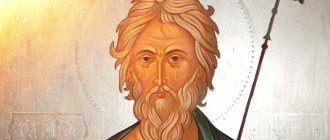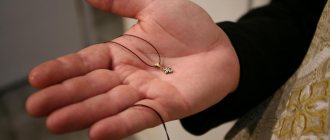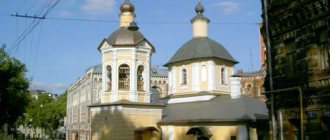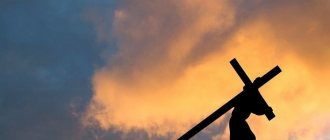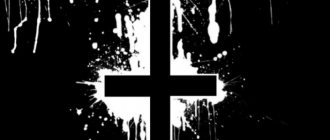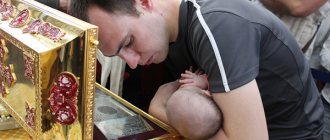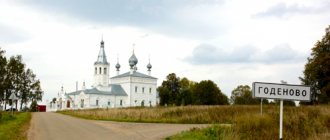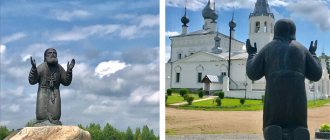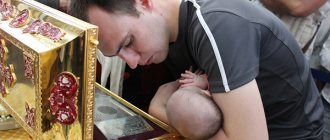In the photo: Kiy cross of Patriarch Nikon in the Church of St. Sergius of Radonezh in Krapivniki, Moscow.
The chopped, torn Kiy cross of Patriarch Nikon waited in the darkness of the museum storage for either “disposal” or some other bitter turn in its fate, when it was brought into the light of God and handed over to the Church of St. Sergius of Radonezh in Krapivniki.
The Kiysky cross in Krapivniki is unique both as a shrine and as a historical monument. “Uniqueness” in this case is not a catchphrase, but the very truth. There are few relics so rich in meaning and so directly connected with the figure of one of the most prominent Primates of the Russian Church throughout its existence. We mean, of course, Patriarch Nikon.
In the “Outline of the Life and Deeds of Nikon, Patriarch of Moscow and All Russia,” compiled by Archimandrite Apollos, the Patriarch’s petition to Tsar Alexei Mikhailovich dated 1656 is quoted:
“In the past year 1639, we, the future Hieromonk, made a procession across the sea from the monastery of Anzersky and during that time we almost drowned due to great sea excitement; but, trusting in the power of the Divine Life-Giving Cross, we receive salvation before the mouth of Onega, to the refuge on Kiy Island, and glory in adoration to our Lord Jesus Christ, crucified on the Cross, for this deliverance. The future will then be on that island, in remembrance of that salvation by hoisting the Holy and Life-Giving Cross in that place.”
The quoted message talks about the establishment of the Monastery of the Cross on Kiy Island - as can be seen from the text, a votive one. And here the Patriarch reports about the Kiy Cross, which he sent to the island “as the first unshakable foundation of that monastery”:
“There is that Honest Life-Giving Cross... brought from Palestine, created from an honest cypress tree, in breadth and height the same as the Life-Giving Cross itself, on which Christ our God willed, by the will, for our salvation, to be crucified, in which is planted a part of that very the Life-Giving Cross, and from the holy relics of many Saints and Martyrs and others; may that Life-giving Cross be honorable, interceding and saving everyone who flows to him at his request and intelligent intention. And if anyone with faith desires to come to that Life-giving Cross for worship, no less by the power of that Holy, Honest and Life-giving Cross, grace will be given, just as to those traveling to the holy places of Palestine, in which Christ our God has fulfilled His holy vision.”
Here, neither more nor less, was the Patriarch’s plan. Large-scale, like everything he planned.
History of the Kiysk cross
According to legend, in 1639, the future Patriarch Nikon escaped during a storm on a deserted island at the mouth of the Onega River. Stepping onto the ground, Nikon asked: “What is this island? (What kind of island is this?)” The island was unsuitable for life and had no name. Then Nikon said: “Let this island be called Kiy.” In memory of his salvation, Nikon installed a simple wooden cross on the island.
Patriarch Nikon (1605–1681). He began a reform to change the liturgical books and rituals of the Russian Church. Among a significant portion of believers, the changes caused a mixed reaction. In 1666, as a simple monk, he was sent to imprisonment in a monastery. His reforms were approved and continued, but the Patriarch himself was acquitted only before his death.
Having become Patriarch, Nikon told Tsar Alexei Mikhailovich about the island, who allowed him to found a monastery there. For the iconostasis of the monastery cathedral in 1656, by order of Patriarch Nikon, a reliquary cross was made, similar in size to the Cross on which Christ was crucified.
The consecration of the cross took place on August 1, 1656 (on the day of the celebration of the Origin of the Honest Trees of the Life-Giving Cross). In memory of this, a corresponding inscription was made on the lower part of the shrine. The Kiysky cross was in the monastery until its closure in 1923. During the Crimean War, in 1854, when there were battles with the British in those places, the cross had to be taken out of the monastery, but then it was returned back. At the same time, some icons of saints were lost. In 1923–1930, the cross was in the anti-religious museum in the Solovetsky camp. In 1991, the shrine was transferred to the Moscow Church of St. Sergius of Radonezh in Krapivniki, where it is available for worship.
Where is:
Moscow, Krapivensky lane, 4, building 2, Church of St. Sergius of Radonezh in Krapivniki.
Temple in Krapivniki
“It’s unusual that your Cross is erected right in front of the entrance,” I ask the first question that comes to mind.
– You saw that the temple was small, and they placed it where the vault is higher. It's a big cross. It was made by order of Nikon in the Holy Land “to the measure of the cross of Christ,” that is, in compliance with the dimensions of the Crucifixion on which the Savior was executed: 3 meters 10 centimeters in height and 1 meter 92 centimeters in width. And in shape it is a copy of the Savior’s tau cross, in the shape of the letter T.
– And this building where we are is somehow Islamic in appearance...
– Here was the courtyard of the Patriarchate of Constantinople, and at one time the temple belonged to it.
– Why is the Kiysky Cross located here now?
– We can say that this is an accident, although providential. But let me tell you better from the very beginning.
Our church of St. Sergius, the Wonderworker of Radonezh, was called by Muscovites differently: “what is in Starye Storozhi”, “what is in Starye Serebryaniki”, “on Petrovka”, “in Krapivniki”, “on Truba”. Basically, it's the same thing. Presumably, the church was built in 1591; the “Petrov Drawing” of 1597 has been preserved, on which you can see a small one-domed temple on the descent from the Vysoko-Petrovsky Monastery to Neglinnaya. That is, the temple already existed under Nikon, and it is quite possible that he prayed here, since he lived nearby. Until the end of the 19th century, it was an ordinary parish church, which eventually became ascribed. When they decided to transfer it to the Serbian courtyard, the people opposed it, because it was the only parish church in Moscow, the main altar of which was consecrated in the name of St. Sergius. The rest were monastic. The requests were heeded and the temple was left assigned to St. Gregory the Theological Church. It was renovated, the iconostasis was gilded, but services were still held only on major holidays. And ten years later, in 1883, by order of Emperor Alexander III, the temple was nevertheless transferred to the courtyard, only of the Patriarchate of Constantinople.
Temple in Krapivniki, old photo
It was then, by 1892, that these buildings, which you called “Islamic,” were erected. Architect Sergei Rodionov decorated the walls with Muslim ornaments, but Russian motifs are also visible in the design. Columns, striped masonry made of colored bricks - it's all Byzantine. As I understand it, the idea was this: Muslims captured Byzantium, but here, in Moscow, Constantinople continues to exist.
House in the “Byzantine-Mohammedan” style
“In 1880, Dostoevsky wrote: “Constantinople must be ours,” I interrupt the story of Fr. Alexandra.
– Yes, at that time, under Emperor Alexander III, there was a question about the liberation of Constantinople and the Orthodox in the Balkans. Perhaps the opening of the farmstead has something to do with this. It was assumed that, as a result of the First World War, the Russians would enter Constantinople, but the revolution turned everything upside down, persecution of the Orthodox began in Russia itself. In the late 20s and early 30s, a wave of mass closures of churches swept across Moscow, but it bypassed Krapivensky Lane. This probably happened because of our eternal sycophancy towards foreigners; the Greeks lived in the courtyard. Perhaps politics was also involved - the Bolsheviks at that time collaborated with Turkey.
It must be said that at the end of the reign of our Patriarch Tikhon, the people of Constantinople were friends here with everyone in the world - both with the renovationists and with the “Tikhonites.” In general, the courtyard had such an unkind, “red-bellied” reputation, and few people came here. Therefore, when the last rector of the metochion, Archimandrite Vasily (Dimopulo), died in 1934, no new priests were appointed here. Those who were junior in rank remained. We established that the last priest, a Crimean Greek by origin, was arrested in January 1938, taken away from here and shot - on charges of espionage for British intelligence. There were no Greek priests left here, and the temple was closed. Moreover, it was closed very thoroughly - everything was taken out of it, nothing was left at all. And the temple was one of the richest in Moscow, judging by the inventory of those valuables that were exported during the confiscation in the 20s.
– And how did the authorities use the temple? Has it been heavily rebuilt?
– They wanted to set up some kind of local history museum, the House of Pioneers. But “at the request of the workers,” they created a skate sharpening station and a workshop that produced these same skates and ski bindings. The fact is that from pre-war times until the early 90s there was a Dynamo skating rink, popular among Muscovites. Have you read Yuri Nagibin’s autobiographical story “Darkness at the End of the Tunnel”? There he writes about his pre-war childhood and the skating rink: “By some miracle, his silver platter fit into the density of the built-up and rebuilt center of Moscow. Here the house encroaches on the house, you won’t find a free spot: between the garbage dump and the garage there is a built-in rabbitry, next to it a shoe shiner has hung out shoelaces and reeks of a sweet shoe polish stench, a cap maker has nestled into some niche, and an electric welder, the owner of a blinding spark, is pressing on him, sheds, substations, all kinds of workshops crowd each other, jostling with elbows, and suddenly the city opens up and, with Dutch generosity, gives its citizens a clear expanse of ice.”
So there was fun and music here for decades - couples rode to the foxtrot “At the samovar, me and my Masha,” and to the songs of Alla Pugacheva. Well, then August 1991 came...
Shrines of the Kiev Cross
-pointed
stars • I
Stone of the Holy Sepulcher •
III
Stone from the cave where the Lord fasted for 40 days •
VI
Stone from the cave where Christ was born •
VIII
Stone of the Sepulcher of the Blessed Virgin Mary •
IX
Stone from the cave where John the Baptist prayed •
XIV
Stone from the cave where John the Baptist hid from Herod •
XV
Stone from the “meal where Abraham treated the Holy Trinity” •
XVI
Stone, part of the rod of Moses, “with which he cut off the Red Sea” •
II, IV, V, VII, X, XI, XII, XIII
Stones not inscribed
Icons and relics of saints
- Great Martyr George the Victorious
- Martyr Christopher
- Martyr Tryphon of Apamea, Nicaea
- Great Martyr Procopius of Caesarea (Palestinian)
- Great Martyr Demetrius of Thessaloniki
- Great Martyr Nikita of Goth, Constantinople
- Great Martyr Mercury of Caesarea (Cappadocia)
- Great Martyr and Healer Panteleimon
- Martyr Anastasius of Aquileia, Salonsky
- Prophet Daniel
- Equal to the Apostles Tsar Constantine
- Apostle and Evangelist Matthew, called Levi
- Apostle Andrew the First-Called
- Prophet, Forerunner and Baptist of the Lord John
- Apostle Paul
- The icon is lost
- Great Martyr Jacob the Persian
- Great Martyr Theodore Stratelates, Heraclean
- Saint Jonah, Metropolitan of Moscow and All Rus'
- Hieromartyr Epherius, Bishop of Chersonesos
- Hieromartyr Cyprian, Bishop of Carthage
- Reverend Alexy, man of God
- Saint Peter of Moscow, Metropolitan of Kiev
- Hieromartyr Theogenes (Fiogenes), Bishop of Paria
- Saint Nektarios, Patriarch of Constantinople
- Hieromartyr Clement, Bishop of Ancyra
- Hieromartyr Peter, Archbishop of Alexandria
- Saint Gregory, Bishop of Nyssa
- Saint Spyridon, Bishop of Trimifuntsky
- Saint Basil the Great, Archbishop of Caesarea in Cappadocia
- Saint John Chrysostom, Archbishop of Constantinople
- Apostle Titus of the 70, Bishop of Crete
- Apostle Stephen from the age of 70, first martyr, archdeacon
- Apostle of the 70 Barnabas (Josiah), Bishop of Milan
- Apostle Thomas Didymus (Gemini)
- Apostle of the 70 and Evangelist Mark
- Righteous Jacob, brother of the Lord according to the flesh
- Apostle of the 70 and Evangelist Luke
- Apostle Timothy of the 70, Bishop of Ephesus
- Righteous Lazarus of the Four Days, friend of God, Bishop of Crete
- Apostle James Zebedee
- Saint Gregory the Theologian, Archbishop of Constantinople
- Hieromartyr Ignatius the God-Bearer, Bishop of Antioch
- Saint John the Merciful, Patriarch of Alexandria
- Hieromartyr Basil, Presbyter of Ancyra
- Saint Epiphanius, Bishop of Cyprus
- Hieromartyr Akepsim, Bishop of Naesson
- Hieromartyr Ermolai, Presbyter of Nicomedia
- Saint Gregory Palamas, Archbishop of Thessalonica (Thessalonian)
- Saint Andrew, Archbishop of Crete
- Hieromartyr Athenogenes, Bishop of Pidakhfoi (Sevastia)
- Saint Philip, Metropolitan of Moscow and All Rus'
- Saint Alexy, Metropolitan of Moscow, Wonderworker of All Rus'
- Saint Gury, Archbishop of Kazan
- Great Martyr Theodore Tiron
- Martyr Eustratius of Sebaste, military leader
- The icon is lost
- Martyr Callinicus of Caesarea (Bifyn)
- Martyr Cyric of Tarsus
- Martyr Callistratus of Byzantium
- Martyr Mamant of Caesarea (Cappadocia)
- Martyr and unmercenary Cosmas of Rome
- Hieromartyr Aviv, Deacon of Edessa
- Hieromartyr Euplus, Archdeacon of Catania (Sicilian)
- Martyr Lucian of Dyrrachium
- Martyr Neophyte of Nicaea
- Martyr and unmercenary Damian of Rome
- Martyr Auxentius of Sebaste, Arabia
- Great Martyr Barbara of Iliopol
- Venerable Anthony the Great, Egyptian
- Venerable Euthymius the Great
- Great Martyr Euphemia of All Praise, Chalcedonian
- Venerable John of Damascus
- Venerable Ephraim the Syrian, Edessa
- Venerable Martyr and Confessor Stephen the New
- Venerable Gregory Dekapolite
- Venerable Pimen the Great
- Venerable Theodore Sikeot, Bishop of Anastasioupol
- Martyr and unmercenary Cyrus of Alexandria
- Rev. George Hozevit
- Rev. Mikhail Malein
- Venerable Nikita, Confessor of Constantinople
- Martyr and unmercenary Cosmas of Arabia, Cilicia
- Venerable Sergius of Radonezh
- Saint Jonah, Archbishop of Novgorod
- Venerable Anthony the Roman, Novgorod
- Righteous Jacob Borovichsky, Novgorod
- Venerable Savva of Storozhevsky, Abbot of Zvenigorod
- Venerable Euthymius of Suzdal
- Blessed Prince Alexander Nevsky
- Blessed Prince Roman Uglichsky
- Great Martyr Marina (Margarita) of Antioch
- Martyr Irene of Aquileia
- Venerable Martyr Anastasia of Rome, Thessalonian (Thessalonian)
- Blessed Prince Vladimir Yaroslavich of Novgorod
- Blessed Prince Georgy (Yuri) Vsevolodovich Vladimirsky
- Holy Blessed Grand Duchess - nun Anna Kashinskaya
- Venerable Martyr Eudokia (Iya) of Rome, Persia
- Venerable Martyr Theodosius the Virgin, Constantinople
- The icon is lost
- The icon is lost
View details:
Kiy cross in the Church of St. Sergius of Radonezh in Krapivniki
Stone from the “meal where Abraham treated the Holy Trinity”
Inscription at the foot of the Cross
Stone of the Holy Sepulcher. Icons and relics of saints, including the Great Martyr George the Victorious, the Great Martyrs Demetrius of Thessalonica and Panteleimon, the Prophet Daniel, Equal-to-the-Apostles Constantine, the Apostles Matthew and Andrew
Stone from the cave where Christ was born. Relics and icons of saints, including St. Andrew of Crete and Gregory of Nyssa
Inscription at the foot of the Cross
“Under the power of the Blessed and Christ-loving Great Sovereign Tsar and Grand Duke Alexy Mikhailovich and all Great and Little and White Russia, the Autocrat and other states of the Sovereign and Possessor, and under the Blessed Empress Tsarina and Grand Duchess Maria Ilyinichna, and under Their Blessed Sovereign Tsarevich and Great Prince Alexy Alexievich created this Great Cross of God by the Grace of Nikon, Archbishop of the reigning city of Moscow and all Great, Little and White Russia, Patriarch, from an honest cypress tree and decorated with silver and gold for the praise and worship of Christians. Christ God! Have mercy and save my soul by the power of the Honest and Life-Giving Cross and the saints for the sake of prayers, whose relics are enshrined in this Cross. From the incarnation of the Word of God 1656, and from the creation of the world 7164 years, August on the first day.”
In the life of Patriarch Nikon there is an appeal to Tsar Alexei Mikhailovich
In the life of Patriarch Nikon we see the following inscription, which he wrote to Tsar Alexei Mikhailovich in 1656:
“In the past year 1639, we, the future Hieromonk, made a procession across the sea from the monastery of Anzersky and during that time we almost drowned due to great sea excitement; but, trusting in the power of the Divine Life-Giving Cross, we receive salvation before the mouth of Onega, to the refuge on Kiy Island, and glory in adoration to our Lord Jesus Christ, crucified on the Cross, for this deliverance. The future will then be on that island, in remembrance of that salvation by hoisting the Holy and Life-Giving Cross in that place.”
In this message we see that we are talking about the establishment of the Monastery of the Cross on the island. We can see this from the content of the text.
Patriarch Nikon himself personally wrote an appeal to Tsar Alexei Mikhailovich. Photo: 3.bp.blogspot.com
Further, Patriarch Nikon reports about the Kiy cross, which he decided to send to the island:
“There is that Honest Life-Giving Cross... brought from Palestine, created from an honest cypress tree, the breadth and height of which is the same as the Life-Giving Cross, on which Christ our God willed, by the will, for our salvation, to be crucified, in which is planted a part of that very the Life-Giving Cross, and from the holy relics of many Saints and Martyrs and others; may that Life-giving Cross be honorable, interceding and saving everyone who flows to him at his request and intelligent intention. And if anyone with faith desires to come to that Life-giving Cross for worship, no less by the power of that Holy, Honest and Life-giving Cross, grace will be given, just as to those traveling to the holy places of Palestine, in which Christ our God has fulfilled His holy vision.”
Nikon writes that this cross is made of honest cypress wood. And it was brought from Palestine. In size it is like the cross on which Jesus Christ was crucified for the salvation of mankind. A part of the wood of the Lord's cross was placed in it. The relics of saints and martyrs were also placed there. The Patriarch writes that the cross in the Wrens will save the entire Christian race. Those who come to him and ask for help will receive grace.
Iconography of the Kiyan Cross
Icon “Kiya Cross with those coming”, 1671:
Icon painter - Bogdan Saltanov (also referred to as Ivan Ievlev(ich) Saltanov; circa 1630–1703) - court artist of Tsar Alexei Mikhailovich, since 1686 - chief master of the Armory Chamber. Armenian by origin, originally from Persia. In Russia he received the name Bogdan (God-given) - a literal translation of his Armenian name Astvatsatur.
This material can be downloaded and printed in A3 format
Photo by Yulia Makoveychuk
Kiy-ostrov, Solovki, Moscow
For many years the Kiysky cross remained in the monastery for which it was intended. It was located in the Cathedral of the Exaltation of the Cross, built in 1660-1661 with the active participation of Nikon himself, who, in the period between leaving the Patriarchal throne and exile, managed to work a lot for the benefit of the monasteries he founded - the Resurrection New Jerusalem monastery near Moscow, Iversky in Valdai and, in fact, Godfather on Kiy-island. The cross, as is known from pre-revolutionary descriptions of the monastery, was placed on the site of the temple image in a wooden, and from 1843, marble icon case, and left the monastery only once, in 1854, when it was “evacuated” due to a military threat from the British. During this evacuation, unfortunately, some (few, however) particles of the relics were lost.
After the revolution, the Cross was taken to Solovki, already a camp then, where it took a place in the exhibition of the local museum, as evidenced by a note in the newspaper “Karelo-Murmansk Territory” (No. 7 for 1927), where the shrine is mockingly called the “divine Department Store.” When the museum on Solovki was closed, the Kiysky Cross ended up in Moscow, where it once began its journey to the mouth of the Onega. Before being transferred to the temple of St. Sergius, the shrine was in the State Historical Museum.
Eight-pointed stars
- Stone of the Holy Sepulcher
- The stone is not inscribed
- Stone from the cave where the Lord fasted for 40 days
- The stone is not inscribed
- The stone is not inscribed
- Stone from the cave where Christ was born
- The stone is not inscribed
- Stone of the Tomb of the Blessed Virgin Mary
- Stone from the cave where John the Baptist prayed
- The stone is not inscribed
- The stone is not inscribed
- The stone is not inscribed
- The stone is not inscribed
- Stone from the cave where John the Baptist hid from Herod
- Stone from the meal, on which Abraham treated the Holy Trinity
- Stone, part of the rod of Moses, used to cut off the Red Sea
Miraculous Icon of the Mother of God “Vladimir”
Church of St. Nicholas in Tolmachi at the Tretyakov Gallery. Address: M. Tolmachevsky lane, 9, st. metro station "Tretyakovskaya", "Polyanka"
In 1999, this most revered and valued icon in the capital was transferred here for storage from the Tretyakov Gallery. This image is the only genuine one, and not preserved in lists (copies). Its existence was first mentioned in 1155. Since then, this image has repeatedly defended our country from enemies; the most illustrious men of Russia prayed before it. What does this have to do with our girls looking for spouses? The fact is that the Mother of God, of course, is the patroness of entire nations, including ours, but in addition to protecting Rus' from Tamerlane, Mehmet-Girey, Hitler and other adversaries, she is known for treating the prayers of young virgins with special trepidation. So a sincere request for a possible marriage will be met with favor by the Most Holy Lady.
The image of the holy martyr Tatiana with a particle of her relics
Church of St. Nicholas of Myra on Three Mountains. Address: Novovagankovsky lane, 9, st. metro station "Barrikadnaya", "1905"
As we know, Saint Tatiana is especially revered by students, whose patron she is with the light hand of Empress Elizabeth Petrovna. But there are quite a few unmarried young ladies among the students, right? And it is quite possible for them to ask this saint for themselves, if not a husband, then at least a admirer.
